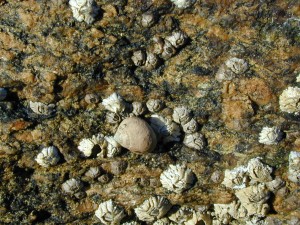Coastal ecosystems as sentinels for climate change
Earlier research examined how biological populations respond to diverse environmental factors at a range of spatial scales, from competitive interactions at the scale of centimeters to variation in food availability and ocean conditions at the scale of tens of kilometers (Menge et al. 2003, Leslie 2005a, Leslie et al. 2005). Using rocky intertidal communities, and particularly barnacles, as a model system, I (HL) found that both population-level (e.g., survival and reproduction) and community-level processes can vary tremendously as a result of these factors.

In 2011, we published an Ecology article on the influence of heat stress on a local to regional scale on the acorn barnacle Semibalanus balanoides. Our key finding – that animals living on smaller substrata are more vulnerable to thermal stress – has implications for the design of protected areas in estuaries, where small substrata (e.g., cobble beaches) often dominate. These habitats appear to be particularly vulnerable to warming, and thus will likely respond more dramatically to a warming world (Gedan et al 2011 Ecology).
The role of physical factors like temperature in shaping rocky shore communities has been known for decades, as have the influence of competition and other biotic interactions. However, such factors are all too often examined in isolation.
Both on New England and Chilean rocky shores, my students and I have examined the influence of multiple interacting biotic and abiotic factors on rocky shore populations, with the aim of generating knowledge that can inform managing for resilience of these ecosystems to climate change (see Bernhardt and Leslie 2013, for a recent synthetic review on this topic). In Chile, for example, undergraduate Emily Lamb and I investigated the relative importance of competition vs. thermal stress in shaping the distribution of two intertidal barnacles Jehlius cirratus and Notochthamalus scabrosus (Lamb et al. 2014). By quantifying abundance, growth, and reproductive potential of the barnacles following a shading experiment conducted at multiple tidal elevations, we found that emersion time, rather than temperature, more strongly influences recruit growth and survival and that aerial temperatures may reinforce the vertical patterns of adult abundance established during settlement. This result underscores the importance of characterizing multiple dimensions of environmental gradients, in order to understand the mechanisms shaping current and future species distributions. For a New England-focused investigation of environmental heterogeneity on marine population dynamics, see Cockrell et al. 2015 Ecosphere.
Like rocky shores, salt marshes are an excellent experimental system for investigating how life history traits respond to environmental heterogeneity and how these responses influence whole ecosystem patterns and processes. They also highly valued for the benefits they provide (e.g., protection from coastal storms and fisheries habitat). To study Atlantic coast marshes’ likely responses to rising temperatures associated with climate change, my former PhD student Sarah Crosby investigated how biomass allocation, phenology, and reproductive potential varies in the foundation species smooth cord grass Spartina alterniflora. See the Publications tab to learn more about our work in this area.
